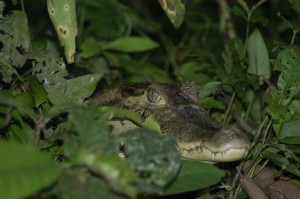The relatively small to medium sized spectacled caiman is the most widely distributed New World crocodilian, ranging from Costa Rica and Mexico in the north to Peru and Brazil in the south. They are named after the bony ridge between the front of the eyes which appears to join the eyes like a pair of spectacles. Although potentially growing up to 2.5 metres in length, the male rarely exceeds about 2 metres, while the female is smaller. Juvenile spectacled caimans are yellowish in colour, with black spots and bands on the body and tail. They live in a range of lowland wetland and river habitats and can tolerate salt as well as fresh water.

Caiman are superbly adapted aquatic predators and most feeding activity takes place during the wet season, with juveniles feeding mainly on insects, crustaceans and snails whilst adults eat fish, amphibians, reptiles and water birds. The largest species are also capable of consuming mammals such as deer and pigs and in dry conditions when food is scarce may also cannibalise smaller caimans.
They usually mate from around May and nest during the wet season, between July and August ensuring that abundant food and suitable habitat will be available when the young hatch. The female lays around 25-40 eggs after approximately 90 days in a nest consisting of a mould of soil and vegetation. The sex of the young is determined by the temperature of incubation, with lower temperatures producing mainly females, and higher temperatures mainly males. The females have strong maternal behaviour and go to extraordinary lengths to look after their young and remain close to the nest throughout the incubation period. Although eggs are sometimes taken by predators or lost to flooding. When they begin to hatch, the females help the eggs to hatch by gently rollling them in the mouth and will carry the hatchlings to water and remain with them for some time. Young caimans often form ‘nursery groups’ consisting of the offspring from several different parents. At the first sign of danger, baby caimans swarm on to the mother’s back for protection.
David Attenborough’s Life in Cold Blood programme followed the softer side of Caiman. Although Steve Backshall was biten by a caiman in Argentina whilst filming for the TV show Deadly 60 which demonstrated these usually quite harmless reptiles can sometimes conform to stereotype. The major threat to the spectacled caiman is now illegal hunting (although less commercially valuable than many other crocodilians) and habitat destruction.
Lloyd Boutcher,
Director Sunvil Traveller




